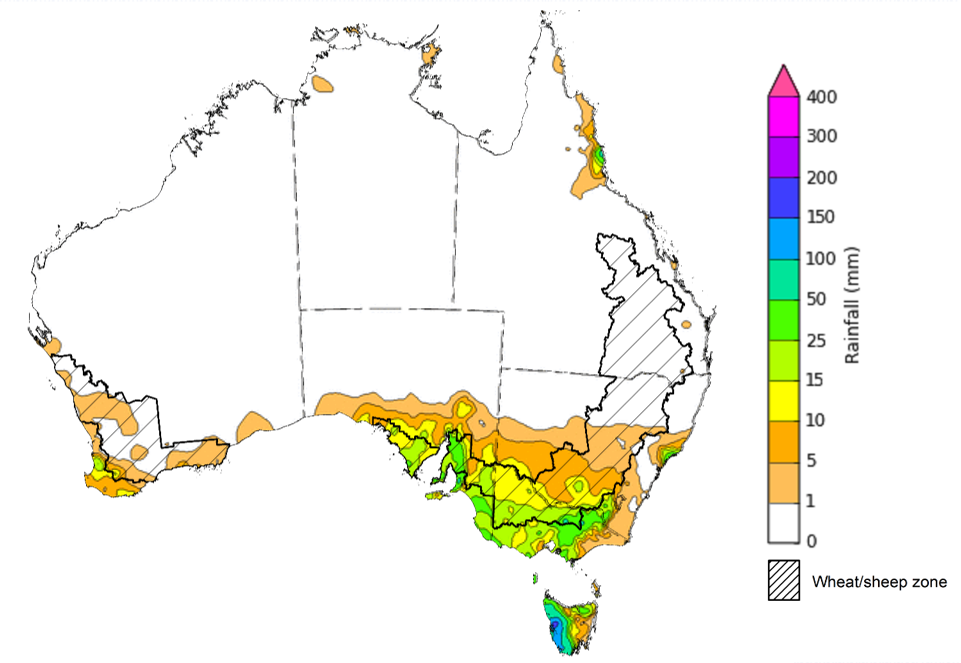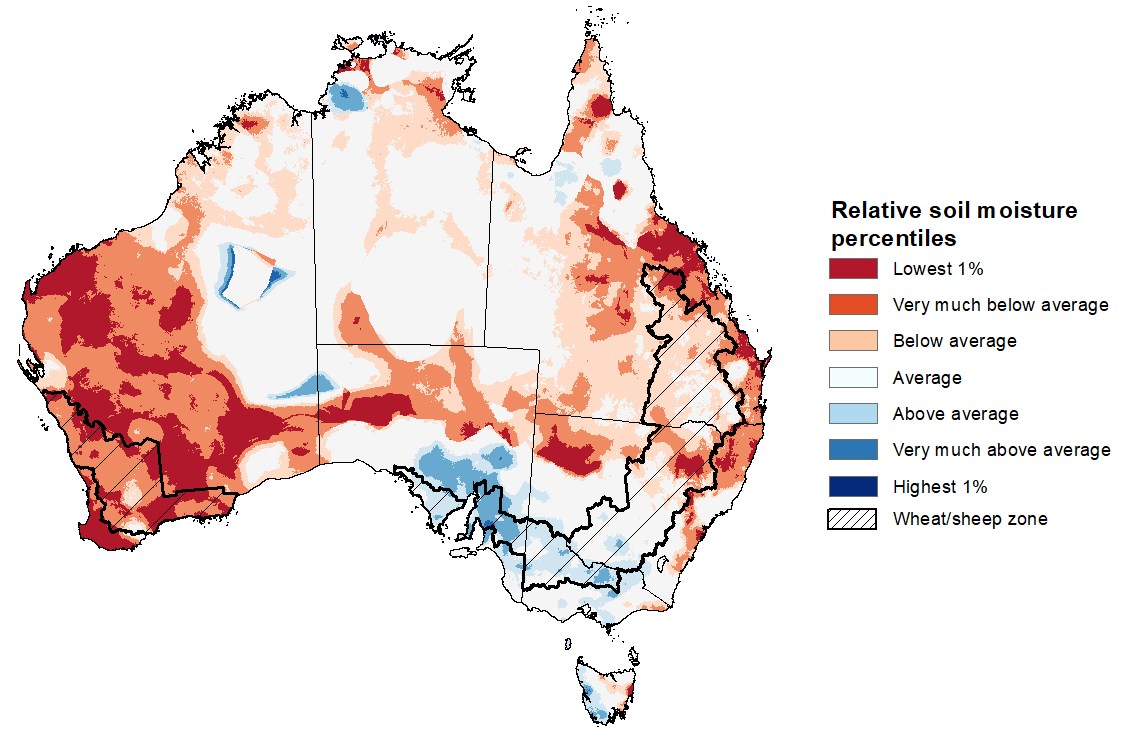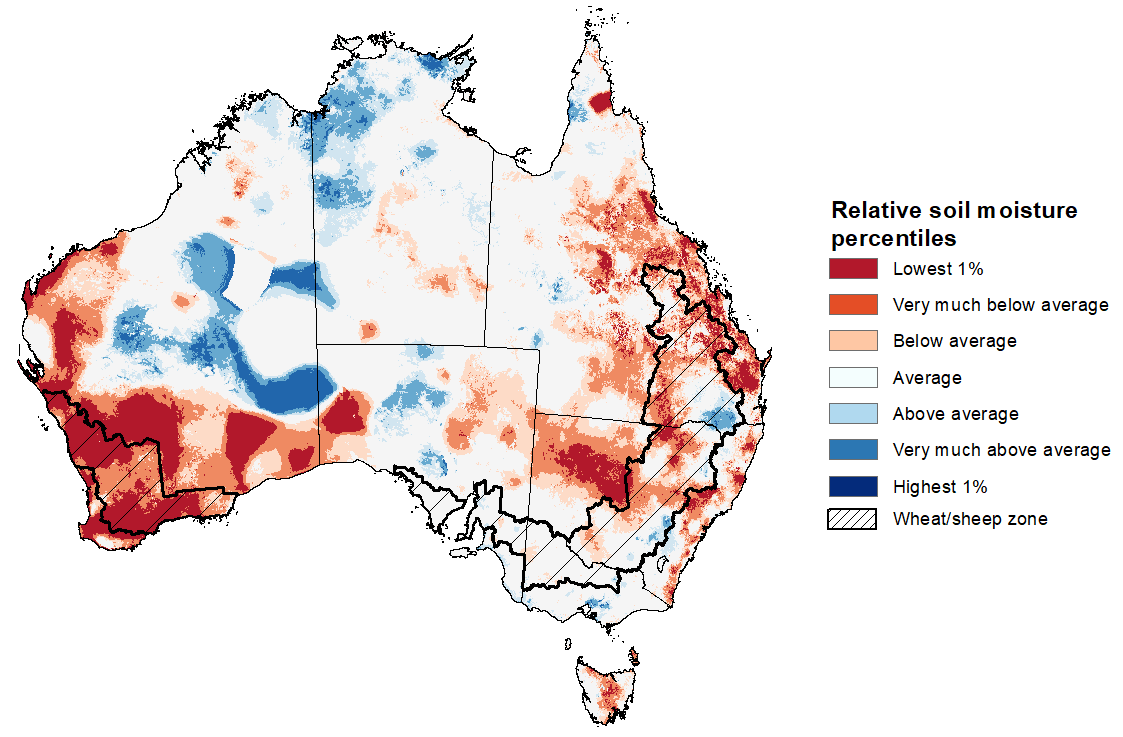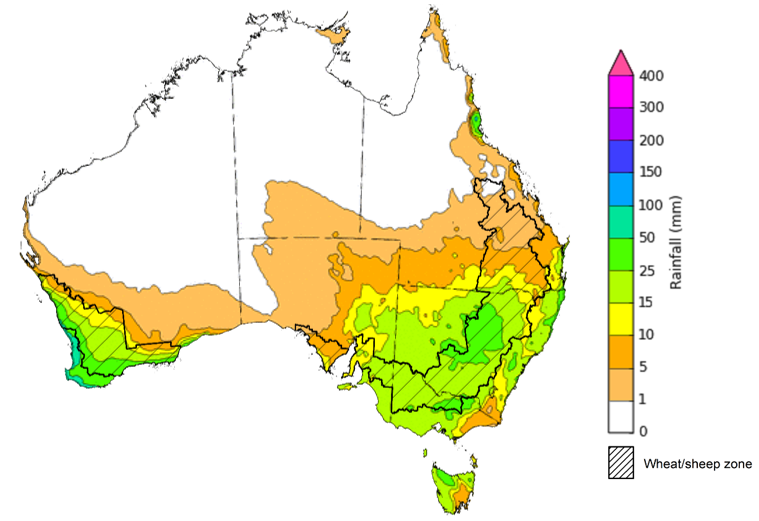Key issues
- For the week ending 31 May 2023, a high-pressure system kept much of the country dry. A number of cold fronts crossed southern Australia bringing showers up to 50 millimetres over Victoria and southern South Australia and up to 25 millimetres in far southwest Western Australia. Showers of up to 200 millimetres were recorded in western Tasmania.
- Across Australian cropping regions, rainfall totals of between 10 to 50 millimetres were recorded in Victoria, South Australia and parts of south-eastern New South Wales. Little to no rainfall was recorded in remaining areas. The dry conditions would have allowed for the harvest of cotton and dry sowing of winter crops to progress without delay. However, the lack of rainfall also presents a downside reproduction risk for winter crops that are starting to show signs of moisture stress following very dry May in some key growing regions (see Section 1.1).
- In the cropping regions, May rainfall was highly variable ranging from severe rainfall deficiencies in the west to well above average falls across parts of the east. May rainfall was generally below average to average in Victoria, South Australia and parts of northern and southern New South Wales. Queensland saw highly variable falls ranging for severely deficient in the north to well above average in the southeast. May conditions were very dry across Western Australia and much of central New South Wales ranging from severely deficient to well below average (see Section 1.2).
- Over the 8-days to 8 June 2023, a low-pressure trough and a series of cold fronts are expected to bring showers up to 50 millimetres over much of New South Wales, Victoria, parts of southern Queensland, eastern South Australia, south-western Western Australia and northern and western Tasmania. A high-pressure system will keep the remainder of the country dry (see Section 1.4).
- Rainfall totals of between 10 and 50 millimetres are expected across most cropping regions over the next 8 days, except for much of central and northern Queensland and western parts of South Australia where totals are expected to be below 10 millimetres. This rainfall will bring some very welcome relief from dry conditions that were seen during May. If realised, these falls should be sufficient to allow for the germination and establishment of dry sown crops, and may give growers confidence to finish intended planting programs in areas with substantial subsoil moisture (see Section 1.4).
- Water storage levels in the Murray-Darling Basin (MDB) increased between 25 May 2023 and 1 June 2023 by 43 gigalitres (GL). Current volume of water held in storage is 20 141 GL. This is 1 percent or 112 GL more than at the same time last year.
- Allocation prices in the Victorian Murray below the Barmah Choke remained steady at $19 from 25 May 2023 to 1 June 2023. Prices are lower in the Murrumbidgee and regions above the choke due to the binding of the Murrumbidgee export limit and Barmah choke trade constraint.
Climate
For the week ending 31 May 2023, a high-pressure system kept much of the country dry. A number of cold fronts crossed southern Australia bringing showers up to 50 millimetres over Victoria and southern South Australia and up to 25 millimetres in far southwest Western Australia. Showers of up to 200 millimetres were recorded in western Tasmania.
Across Australian cropping regions, rainfall totals of between 10 to 50 millimetres were recorded in Victoria, South Australia and parts of south-eastern New South Wales. Little to no rainfall was recorded in remaining areas. The dry conditions would have allowed for the harvest of cotton and dry sowing of winter crops to progress without delay. However, the lack of rainfall also presents a downside reproduction risk for winter crops that are starting to show signs of moisture stress following very dry May in some key growing regions.
Rainfall for the week ending 31 May 2023
Issued: 31/05/2023
Note: The rainfall analyses and associated maps utilise data contained in the Bureau of Meteorology climate database, the Australian Data Archive for Meteorology (ADAM). The analyses are initially produced automatically from real-time data with limited quality control. They are intended to provide a general overview of rainfall across Australia as quickly as possible after the observations are received. For further information go to http://www.bom.gov.au/climate/rainfall/
Rainfall during May 2023 was well below average for much of Australia. The main exceptions have been in parts of Cape York Peninsula and southeast Queensland, parts of northern and south-eastern New South Wales, much of Victoria, southern agricultural districts of South Australia as well as in western Tasmania where May rainfall has been average to above average.
In the cropping regions, May rainfall was highly variable ranging from severe rainfall deficiencies in the west to well above average falls across parts of the east. May rainfall was generally below average to average in Victoria, South Australia and parts of northern and southern New South Wales. Queensland saw highly variable falls ranging for severely deficient in the north to well above average in the southeast. May conditions were very dry across Western Australia and much of New South Wales ranging from severely deficient to well below average. The dry conditions would have allowed most producers to finalise the harvesting of summer crops without delay.
However, lack of rainfall in May affected germination of early planted winter crops (cereals), except for in southern Queensland. However, below average rainfall across some growing regions in New South Wales, Queensland and Western Australia this planting season is expected to curtail planting intentions, resulting in significant levels of available land being left fallow over winter in these areas.
Rainfall percentiles for May 2023
Upper layer soil moisture as at 30 May 2023 was very much below average to below average for this time of year across much of the country. Extremely low upper layer soil moisture was evident across large areas of Western Australia, eastern Queensland, northern South Australia and northern New South Wales. Above average upper layer soil moisture was evident in northern Victoria, southern South Australia, and western Tasmania.
At this time of year, upper layer soil moisture is important for the germination and establishment of winter crops across Australian cropping regions. It is also important indicator of the ability to access paddocks to undertake harvesting of summer crops in New South Wales and Queensland, as well as planting activities for winter crops.
In the cropping regions, upper layer soil moisture as at 30 May 2023 was extremely low to below average in Queensland, northern New South Wales, and much of Western Australia. Above average upper layer soil moisture was evident in Victoria and South Australia cropping regions. Upper layer soil moisture was average across central and southern New South Wales. The below average to average upper layer soil moisture in Queensland would have allowed field access for summer crop harvesting and field preparation for winter crop sowing. The above average upper layer soil moisture levels across southern cropping regions should have been sufficient to support the germination and establishment of winter crops, but prevented some field access for follow up winter crop planting.
Modelled upper layer soil moisture on 30 May 2023
Source: Bureau of Meteorology (Australian Water Resources Assessment Landscape model)
Lower layer soil moisture as at 30 May 2023 was average across much of Australia, except for large areas of eastern Queensland, northern and central New South Wales and Western Australia where it was extremely low to below average.
Lower layer soil moisture is a larger, deeper store that is slower to respond to seasonal conditions and tends to reflect the accumulated effects of events that have occurred over longer periods. Crop development and pasture growth in areas of above average lower layer soil moisture are typically less reliant on in-season rainfall than in areas with below average lower layer soil moisture.
In cropping regions, lower layer soil moisture was generally very much below average to average in Queensland and New South Wales with southeast Queensland being the main exception where it was above average. Lower layer soil moisture was extremely low to very much below average in Western Australia, generally average in Victoria and South Australian cropping regions. Areas with below average levels of lower layer soil moisture will be highly dependent on timely and sufficient in-season rainfall to support average winter crop production prospects.
Modelled lower layer soil moisture on 30 May 2023
Source: Bureau of Meteorology (Australian Water Resources Assessment Landscape model)
Over the 8-days to 8 June 2023, a low-pressure trough and a series of cold fronts are expected to bring showers up to 50 millimetres over much of New South Wales, Victoria, parts of southern Queensland, eastern South Australia, south-western Western Australia and northern and western Tasmania. A high-pressure system will keep the remainder of the country dry.
Rainfall totals of between 10 and 50 millimetres are expected across most cropping regions, except for much of central and northern Queensland and western parts of South Australia where totals are expected to be below 10 millimetres. This rainfall will bring some very welcome relief from dry conditions that were seen during May. If realised, these falls should be sufficient to allow for the germination and establishment of dry sown crops, and may give growers confidence to finish intended planting programs in areas with substantial subsoil moisture.
Total forecast rainfall for the period 1 June 2023 to 8 June 2023
Note: This rainfall forecast is produced from computer models. As the model outputs are not altered by weather forecasters, it is important to check local forecasts and warnings issued by the Bureau of Meteorology.
Water
Water storages, water markets and water allocations - current week
The Tableau dashboard may not meet accessibility requirements. For information about the contents of these dashboards contact ABARES.
Commodities
Information on weekly price changes in agricultural commodities is now available at the Weekly commodity price update.





